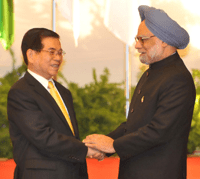Even as Vietnam and China continue to conduct tit-for-tat naval maneuvers in the South China Sea, Hanoi has started making direct calls for foreign involvement in the two nations' maritime territorial dispute. While many commentators saw this as a thinly veiled invitation to the United States, it could also be a precursor to India establishing a permanent presence in Vietnamese waters. India has apparently responded favorably to Vietnam's offer of permanent berthing rights in Na Thrang port. The move would not only add military heft to India's "Look East" policy, but is also emblematic of a larger Indian effort to counter China's activities in South Asia.
Although Vietnam more than held its own in its 1979 border war with China, its record against the latter at sea is less impressive, as incidents in both 1974 and 1988 show. Even in 1979, Chinese naval action against Vietnam was only checked by the presence of Soviet ships. Since then the asymmetry in naval power between China and Vietnam has grown exponentially in the former's favor, while Hanoi has lost its Soviet-era security guarantees. Although Vietnam's decision to hold live naval drills in the wake of the cable-cutting incident in mid-June was seen as a show of resolve, it did little to temper ongoing Chinese surveys in disputed areas.
Clearly Vietnam requires a more credible naval power to intercede on its behalf to prevent the Chinese from upping the ante any further. That power could be India. In a move that had been in the offing for some time, India appears to have finally greenlighted long-term basing for it ships at Na Thrang, just south of China's new naval base at Sanya on Hainan Island.

